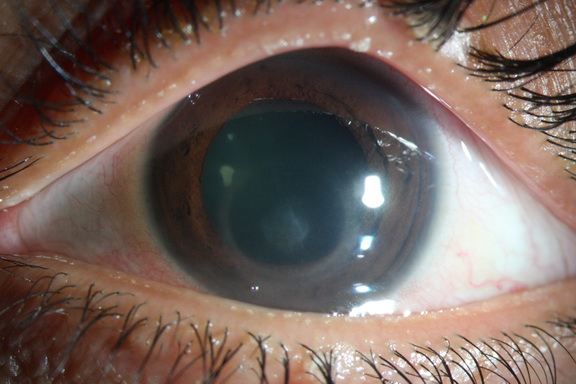Presumed Herpes simplex virus reactivation following LASIK mimicking diffuse lamellar keratitis
Abstract
We report a rare presentation of herpetic stromal keratitis reactivation in a 43-yearold patient who underwent LASIK previously and presented with complaints of photophobia, pain, and redness. On examination, mild congestion was noted with deep-seated, ring-like infiltrate under the LASIK flap with some amount of scarring that was initially confused with diffuse lamellar keratitis. A detailed repeated history led to diagnosing herpetic keratitis reactivation that with timely treatment of antivirals and steroids helped us to achieve a good anatomic and visual outcome for the patient.
References
subsequent corneal perforation. CLAO J. 2002;28:69-71.
2. Dhaliwal DK, Romanowski. Experimental laser-assisted in situ keratomileusis induces the
reactivation of latent herpes simplex virus. Am J Ophthalmol. 2001;131:506-507.
3. Jin GJ, Lyle WA, Merkley KH. Late-onset diffuse lamellar keratitis after a laser in situ
keratomileusis. J Cataract Refract Surg. 2005;31(2):435-437.
4. Probst LE, Foley L. Late-onset interface keratitis after uneventful laser in situ keratomileusis. J
Cataract Refract Surg. 2001;27(7):1124-1125.
5. Levy J, Lapid-Gortzak R. Herpes simplex virus keratitis after laser in situ keratomileusis. J Refract
Surg. 2005; 21:400-402.
6. Davidorf JM. Herpes simplex keratitis after LASIK. J Refract Surg. 1998;4:667.

Copyright (c) 2019 Asian Journal of Ophthalmology

This work is licensed under a Creative Commons Attribution 4.0 International License.
Authors who publish with this journal agree to the following terms:
- Authors retain copyright and grant the journal right of first publication, with the work twelve (12) months after publication simultaneously licensed under a Creative Commons Attribution License that allows others to share the work with an acknowledgement of the work's authorship and initial publication in this journal.
- Authors are able to enter into separate, additional contractual arrangements for the non-exclusive distribution of the journal's published version of the work (e.g., post it to an institutional repository or publish it in a book), with an acknowledgement of its initial publication in this journal.
- Authors are permitted and encouraged to post their work online (e.g., in institutional repositories or on their website) prior to and during the submission process, as it can lead to productive exchanges, as well as earlier and greater citation of published work (See The Effect of Open Access).


